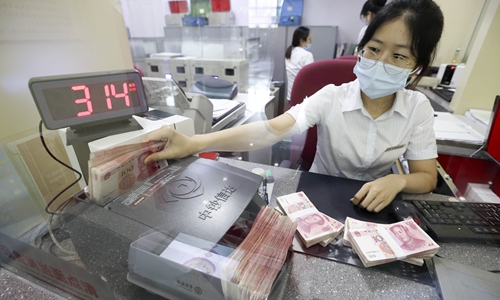US hegemony pushes the yuan to go global: expert
By Xie Jun and Chi Jingyi Source: Global Times Published: 2020/8/16 16:38:40
US hostility pushes firms away from dollar

An employee counts yuan at a bank in Taiyuan, North China's Shanxi Province, on August 6. Photo: CNSphoto
The Chinese yuan is going global at an increasingly faster rate, becoming the world's 5th most-used settlement currency in 2019 with cross-border transactions rising by 24 percent.
Experts say that the trend is partly due to the growing tendency of global companies to steer clear of the US dollar, fearing their business could be compromised by the Trump administration's protectionist policies.
The total sum of cross-border yuan payments and receipts by banks was 19.67 trillion yuan ($2.83 trillion) in 2019, growing by 24.1 percent on a yearly basis and reaching a record high in turnover volume, according to the 2020 RMB International Report, released by the People's Bank of China (PBC), the central bank, on Friday.
Market share of the yuan in foreign exchange trading was 4.3 percent, up 0.3 percentage points on 2016. The report showed that the yuan ranked 5th as the most-used global settlement currency, with a market share of 1.76 percent.
US hegemony
"In general, it is clear to see that the yuan is accelerating the process of going global," Zhou Yu, director of the Research Center of International Finance at the Shanghai Academy of Social Sciences, told the Global Times on Saturday.
Several Chinese economists attributed this trend in part to the US' rising hegemony, which they say is pushing global companies away from the US dollar.
"Overseas companies that have business interactions with China are increasingly inclined to shun the US dollar, for fear their business will be affected by Trump's hostile policies toward China," Xi Junyang, a professor at the Shanghai University of Finance and Economics, told the Global Times.
A PBC survey on 500 trading companies revealed that around 84.6 percent of enterprises have chosen the yuan as the currency for cross-border settlement, mainly to "mitigate foreign exchange risks," the PBC report noted.
Xi said the US has demonstrated a clear tendency toward isolationism, causing friction in a number of countries.
This is creating a fear of dealing in US dollars and worries over financial retaliation by the US government.
"The more economic sanctions the US government rolls out against China, the more firmly China will push the yuan's internationalization, so that China's economy will no longer rely on the dollar," Xi said.
Time to go global
"I believe the time is right for the yuan to go global, with US protectionism triggering disgust in the international community and the Chinese economy rising," Zhou said, adding that the yuan's internationalization will be enhanced as China takes measures to liberalize capital accounts.
Zhou noted that the US dollar has depreciated because of the US economy's slump and the country's quantitative easing, moving investors away from the dollar and toward currencies that are more stable, including the yuan.
According to the Currency Composition of Official Foreign Exchange Reserves (COFER) data of the IMF, by 2019, the scale of yuan reserves reached $217.67 billion, accounting for 1.95 percent of all foreign exchange reserves of central banks, ranking the fifth, surpassing the Canadian dollar's 1.88 percent, which is the highest level since the IMF began to publish the yuan reserve assets in 2016.
More than 70 central banks or monetary authorities around the world are keeping the yuan in their foreign exchange reserves.
"China's bond market has attracted many foreign investors this year. The opening up of the capital account and the expansion of the yuan offshore market are complementary to the increasing use of the yuan for cross-border payments," Ding Meng, an economist at the Bank of China (Hong Kong), told the Global Times.
Ding said that the growth in the cross-border use of the yuan is closely related to the vitality of China's foreign trade.
As for this year, the first 6 months may see some negative impact, due to the coronavirus epidemic, as overall growth of imports and exports has declined. But on the whole, as long as foreign trade can maintain steady growth, the use of the yuan will rise.
China-Russia de-dollarization
On the one hand, the growth of China's foreign trade has boosted the use of the yuan in trade settlements, on the other hand, to offset the financial retaliation by the US, China and Russia have been working together to move away from the US dollar in recent years.
Data from Russia's Central Bank and Federal Customs Service showed that the use of the dollar in China-Russia bilateral trade has been cut drastically, with the dollar used for only 46 percent of settlements in trade in the first quarter of this year, down from 75 percent in 2018, falling below 50 percent for the first time on record.
Meanwhile, out of the remaining 54 percent, the euro accounted for 30 percent, while the ruble took 7 percent.
The yuan took 17 percent, setting a new high.
The "de-dollarization" was in response to the "unpredictability of US economic policy and the rising abuse by Washington of the dollar's status as the world's major reserve currency," said Russian Minister of Foreign Affairs Sergey Lavrov, Russian News Agency Tass reported.
Newspaper headline: Yuan going global